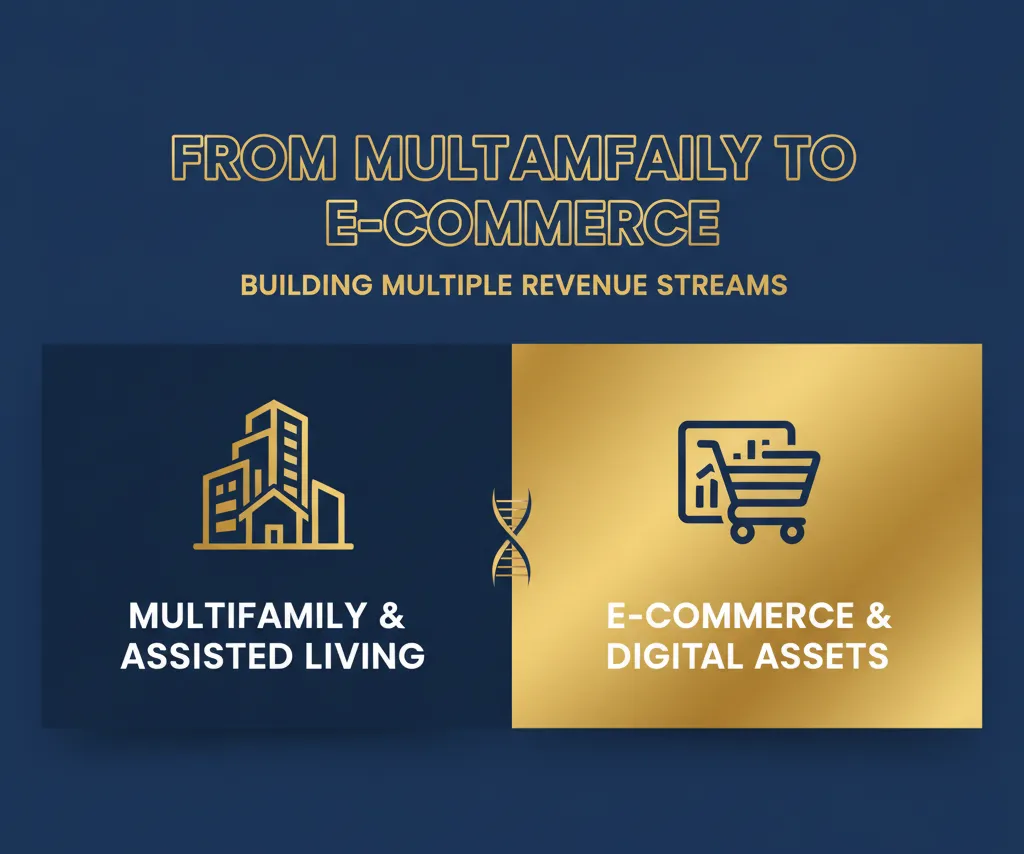
From Multifamily to E-Commerce: How Two Investors are Building Multiple Revenue Streams in 2025
“Be Clear, Be Grateful and Listen”
From Multifamily to E-Commerce: How Two Investors are Building Multiple Revenue Streams in 2025
The investment landscape is evolving rapidly, and smart investors are diversifying beyond traditional real estate into emerging digital markets. A recent conversation between yacht captain turned investor Scott Kidd and real estate entrepreneur Julian Sanchez reveals compelling strategies for building sustainable, scalable income streams across both physical and digital assets.
The Assisted Living Gold Rush: Capitalizing on Baby Boomer Demographics
Julian Sanchez and his partners have identified a massive demographic shift creating unprecedented investment opportunities. After six years of multifamily investing across multiple states, they've pivoted into assisted living facilities, and the numbers tell a compelling story.
"We recently ventured into the assisted living facility sector, which we found promising due to the retiring baby boomer population," Julian explained. This isn't just a hunch; it's a data-driven play on one of the most predictable demographic trends in American history.
However, Julian was quick to point out the operational complexities. Unlike multifamily properties that can be managed remotely, assisted living facilities require full-time staff and administrators to ensure 24/7 operations. The trade-off? Significantly better profit margins despite higher operational intensity.
The Multifamily Reality Check: Higher Revenue, Lower Profits
One of the most surprising insights from their conversation challenges conventional real estate wisdom. While multifamily properties generate higher revenue streams, Julian revealed they actually produce lower profit margins than assisted living facilities due to higher expense ratios.
The operational challenges are real, particularly with Class C properties. "Class C properties require more upkeep and have higher tenant turnover rates," Julian noted. Success in this sector often comes down to finding exceptional on-site management, like Giovanni, their skilled handyman who has transformed the appearance and operations of their properties.

The E-Commerce Arbitrage Revolution: Riding the Trillion-Dollar Wave
Perhaps the most intriguing aspect of Julian's portfolio is his direct-to-consumer e-commerce operation. His business model is elegantly simple yet incredibly scalable: buy products for a dollar, sell them for two, and amplify profits through strategic credit card rewards optimization.
The timing couldn't be better. Julian's business operates within the exploding online marketplace ecosystem, which is projected to reach one trillion dollars in holiday sales alone. His approach eliminates traditional e-commerce headaches by partnering with established brands and letting suppliers handle fulfillment, no inventory, no warehousing, no shipping logistics.
The 24/7 Cash Flow System: Building Predictable Income Streams
What sets Julian's approach apart is his focus on consistent, automated revenue generation. His e-commerce operation provides weekly payments, creating a steady cash flow that complements the monthly income from real estate investments.
The partnership model is equally compelling: Julian splits profits 50/50 with clients, aligning incentives and reducing individual risk while scaling operations. This approach allows him to grow multiple stores simultaneously without proportionally increasing his time investment.
The People-First Philosophy: Why Relationships Drive Returns
Both investors emphasized a crucial but often overlooked principle: treating people well across all stakeholder relationships. Whether dealing with residents, employees, or investors, Scott stressed that success in property management, and business generally, comes down to prioritizing human relationships.
This philosophy extends beyond mere customer service. It's about creating systems and environments where everyone involved has incentives to succeed, from on-site staff to investment partners to end customers.

Emerging Market Opportunities: The Digital Real Estate Play
Julian's e-commerce model represents what could be considered "digital real estate", claiming territory in online marketplaces and building recurring revenue streams. Just as physical real estate benefits from location and demographics, digital marketplace success depends on understanding platform algorithms, customer behavior, and market trends.
The barrier to entry is significantly lower than traditional real estate, but the knowledge requirements are different. As Julian noted when Scott asked about buying existing stores, "it's possible but requires both the know-how and the ability to operate the business."
Integration Strategy: Combining Physical and Digital Assets
The most sophisticated investors are no longer choosing between real estate and digital businesses, they're building portfolios that leverage both. Julian's combination of assisted living facilities and e-commerce operations creates:
Diversified revenue streams across different economic cycles
Scalable systems that can grow without proportional time increases
Multiple exit strategies for each asset class
Hedge against market volatility through uncorrelated income sources
Key Takeaways for Modern Investors
1. Demographics Drive Opportunity: The baby boomer retirement wave creates massive opportunities in assisted living, but operational complexity requires careful planning.
2. Profit Margins Matter More Than Revenue: Don't be fooled by gross numbers, analyze expense ratios and net returns across different asset classes.
3. People Are Your Greatest Asset: Whether it's finding a Giovanni for property management or building strong supplier relationships for e-commerce, success depends on human connections.
4. Diversification Beyond Real Estate: E-commerce and digital marketplace opportunities can provide complementary income streams with different risk profiles.
5. Partnership Models Scale Faster: Splitting profits 50/50 with operational partners can accelerate growth while reducing individual risk.
The investment landscape of 2025 rewards those who can successfully navigate both physical and digital assets while maintaining a people-first approach to business relationships. Julian and Scott's conversation reveals that the most successful investors are those building integrated, diversified portfolios designed for multiple economic scenarios.

